Another Day in the Life of a Language Assistant in Spain
Last year on the blog, I wrote a post about what a typical day in Spain looked like for me. Of course, my life this year has looked a little different now that I’m living in a completely different part of the country (Santiago de Compostela in the northwest). I’ve put together below something to give y’all an idea of what life as an auxiliar de conversación is like—but reader beware: this is only my individual experience, and even people living in the same city can have wildly varying times in this program. Hope you find this interesting!
My morning schedule is surprisingly similar to the one I had my first year: I get up around 7am (sometimes later…), have breakfast, shower, pack a lunch, and dash out the door not long after the nearby monastery’s bells chime out eight-o’-clock. I always enjoy walking the quarter of an hour it takes to get from my apartment across town to the carpool pickup spot, as Santiago is calm and doesn’t have much car or foot traffic. It’s usually not raining, too, which is a major plus.
Fran, my bilingual coordinator, arrives at 8:25am at the “rendezvous point” and I hop in her car. We then head to Milladoiro, a bedroom community outside of Santiago where we pick up another teacher (or pile into his car, depending on whose week it is) and begin the commute to school.
It’s about half an hour from Milladoiro to Abanqueiro where our school is. In the first 15 minutes, we pass through dozens of tiny villages, roll around hills, go in and out of forests, and pass by rural homes, chapels, and vineyards. By the time we get to Padrón, we shift into high gear and merge onto the highway that traces the coast of the Ría de Arousa, a narrow inlet of the Atlantic Ocean.
We usually arrive about five minutes before classes start—at 9:30am—and in this narrow window of time, teachers corral the amazingly loud students who congregate in the hallways, converse with their colleagues, down some drip-coffee from the teachers’ lounge, or deal with bureaucratic official things in the offices.
The bell rings at 9:30, but classes don’t start until 9:40, because the kids have to get all settled in and then spend time reading quietly to themselves. In the morning, we have two periods (the first ends at 10:40, the second at 11:35) before recreo or recess, then another from 12:05 to 1:00pm, at which point the whole school shuts down and the kids either go home for lunch or the school’s cafeteria. At 3:15, everyone comes back to school and we have two 45-minute periods, leaving at last at 4:45.
This split-schedule is super awkward for us teachers who commute from out of town, but because the school is in such a small town, it’s no big deal for parents to come and pick up their kids for lunch, which is the main meal of the day in Spain.
On Monday mornings, I plan the week’s lessons with Fran. We always go through the textbooks and workbooks and figure out what activities we’re going to assign, but sometimes we put together vocabulary lists and prepare special events.
Of the 12 periods I work in, I’m only in four of them with Fran; i.e., this English teacher is alone in the other eight classes. This hasn’t ever been a big deal for me, despite never having studied education in college, because Fran is always super helpful in showing me the ropes. It also helps that there’s always another teacher in the classroom to keep the kids quiet or to translate complex directions for a game.
In most of my elementary classes (3rd through 6th grade), I usually follow a routine of talking about the date and weather before playing a game to practice vocabulary or singing a song. Then we delve into the textbook and I lead lots of question like “okay….who is wearing a red shirt…and standing in the living room?” After textbook work, I set the kids loose on some activity book problems and go around the room, answering their questions, translating, or explaining the directions.
In my preschool classes (3- to 5-year-olds), I begin with singing some songs, then we either learn or practice English vocabulary while I panic and try find some way to play a game integrating words like “grandma” and “brother” before we all Go To The Tables!!! and hit the activity books, which are mainly just coloring, pattern recognition, and stickers—but a great way to reinforce the vocabulary we just learned. Once a month, we use the digital activities on the touch-screen whiteboard, which the kids go gaga over. They love getting to play the computer games even though they don’t realize they’re actually practicing English!
During the midday break, I eat lunch in our small faculty dining room with the other teachers who are stuck at school. Afterward, I like to read a book, write on the blog, or if it’s not raining, walk around town. On Tuesdays, because the teachers have to stay really late after school for meetings, we all go out to lunch at a nice restaurant in town and spend the whole two hours chit-chattin’ and takin’ it easy.
By the time I leave school, get dropped off in Santiago, and walk back home (resisting the Siren song of chocolate napolitanas from streetside bakeries), it’s about six in the evening. Although Spanish dinner time officially begins at nine at night, sometimes I simply don’t care and have supper when I get home (after all, I have lunch at 1pm so it’s not that different from American schedules). Or I just wait until I’m a little bit hungrier.
This year, I haven’t been very persistent about picking up private English classes, but on Monday evenings, I give a middle-aged Spanish couple a conversation class for an hour.
Weekends are much different, especially since they are four days long (please don’t hate me!). My bilingual coordinator was able to move the puzzle pieces of my schedule around so I get Thursdays and Fridays off, but have to work my 12 hours a week all day Monday through Wednesday. Since my school is an hour away each direction, I think it works out for the best.
Side note: the Ministry of Education doesn’t let us assistants work more than 12 hours per week, so you might call it “underemployment,” but at least they pay us a living wage and there are opportunities for private classes on the side, so it’s not a bad deal at all.
Anyway, weekends are my time for Getting Things Done™, which can include: going to the bank to pay the rent, ordering and receiving new bombonas or butane gas tanks to power the water heater and stovetop, sending mail at the post office, going to the market for fresh food before they close at 2pm, buying the rest of the groceries at the supermarket, writing posts for this very blog, sifting through, editing, geotagging, uploading, and tagging photos, reading novels, going on hikes, hanging out with friends over tapas, strolling around town, checking out random churches or museums in town, going on daytrips to towns and villages in the surrounding area, FaceTime-ing with friends and family, cooking meals to last me the week, taking siestas, baking cookies, and drinking tea.
If you’ve ever been an auxiliar de conversación before, how did your daily schedule compare to the one I’ve just described? Tell me your experience in the comments below!
In the morning
 |
| My street |
My morning schedule is surprisingly similar to the one I had my first year: I get up around 7am (sometimes later…), have breakfast, shower, pack a lunch, and dash out the door not long after the nearby monastery’s bells chime out eight-o’-clock. I always enjoy walking the quarter of an hour it takes to get from my apartment across town to the carpool pickup spot, as Santiago is calm and doesn’t have much car or foot traffic. It’s usually not raining, too, which is a major plus.
Fran, my bilingual coordinator, arrives at 8:25am at the “rendezvous point” and I hop in her car. We then head to Milladoiro, a bedroom community outside of Santiago where we pick up another teacher (or pile into his car, depending on whose week it is) and begin the commute to school.
It’s about half an hour from Milladoiro to Abanqueiro where our school is. In the first 15 minutes, we pass through dozens of tiny villages, roll around hills, go in and out of forests, and pass by rural homes, chapels, and vineyards. By the time we get to Padrón, we shift into high gear and merge onto the highway that traces the coast of the Ría de Arousa, a narrow inlet of the Atlantic Ocean.
 |
| Neighborhood plaza near the school |
We usually arrive about five minutes before classes start—at 9:30am—and in this narrow window of time, teachers corral the amazingly loud students who congregate in the hallways, converse with their colleagues, down some drip-coffee from the teachers’ lounge, or deal with bureaucratic official things in the offices.
At school
 |
| Time for school! |
The bell rings at 9:30, but classes don’t start until 9:40, because the kids have to get all settled in and then spend time reading quietly to themselves. In the morning, we have two periods (the first ends at 10:40, the second at 11:35) before recreo or recess, then another from 12:05 to 1:00pm, at which point the whole school shuts down and the kids either go home for lunch or the school’s cafeteria. At 3:15, everyone comes back to school and we have two 45-minute periods, leaving at last at 4:45.
This split-schedule is super awkward for us teachers who commute from out of town, but because the school is in such a small town, it’s no big deal for parents to come and pick up their kids for lunch, which is the main meal of the day in Spain.
On Monday mornings, I plan the week’s lessons with Fran. We always go through the textbooks and workbooks and figure out what activities we’re going to assign, but sometimes we put together vocabulary lists and prepare special events.
Of the 12 periods I work in, I’m only in four of them with Fran; i.e., this English teacher is alone in the other eight classes. This hasn’t ever been a big deal for me, despite never having studied education in college, because Fran is always super helpful in showing me the ropes. It also helps that there’s always another teacher in the classroom to keep the kids quiet or to translate complex directions for a game.
 |
| Me and the 6th graders |
In most of my elementary classes (3rd through 6th grade), I usually follow a routine of talking about the date and weather before playing a game to practice vocabulary or singing a song. Then we delve into the textbook and I lead lots of question like “okay….who is wearing a red shirt…and standing in the living room?” After textbook work, I set the kids loose on some activity book problems and go around the room, answering their questions, translating, or explaining the directions.
In my preschool classes (3- to 5-year-olds), I begin with singing some songs, then we either learn or practice English vocabulary while I panic and try find some way to play a game integrating words like “grandma” and “brother” before we all Go To The Tables!!! and hit the activity books, which are mainly just coloring, pattern recognition, and stickers—but a great way to reinforce the vocabulary we just learned. Once a month, we use the digital activities on the touch-screen whiteboard, which the kids go gaga over. They love getting to play the computer games even though they don’t realize they’re actually practicing English!
 |
| Comfort food for Tuesday lunch |
During the midday break, I eat lunch in our small faculty dining room with the other teachers who are stuck at school. Afterward, I like to read a book, write on the blog, or if it’s not raining, walk around town. On Tuesdays, because the teachers have to stay really late after school for meetings, we all go out to lunch at a nice restaurant in town and spend the whole two hours chit-chattin’ and takin’ it easy.
At home
 |
| View on my walk home |
By the time I leave school, get dropped off in Santiago, and walk back home (resisting the Siren song of chocolate napolitanas from streetside bakeries), it’s about six in the evening. Although Spanish dinner time officially begins at nine at night, sometimes I simply don’t care and have supper when I get home (after all, I have lunch at 1pm so it’s not that different from American schedules). Or I just wait until I’m a little bit hungrier.
This year, I haven’t been very persistent about picking up private English classes, but on Monday evenings, I give a middle-aged Spanish couple a conversation class for an hour.
On the weekend
 |
| Praza das Praterías, Santiago de Compostela |
Weekends are much different, especially since they are four days long (please don’t hate me!). My bilingual coordinator was able to move the puzzle pieces of my schedule around so I get Thursdays and Fridays off, but have to work my 12 hours a week all day Monday through Wednesday. Since my school is an hour away each direction, I think it works out for the best.
Side note: the Ministry of Education doesn’t let us assistants work more than 12 hours per week, so you might call it “underemployment,” but at least they pay us a living wage and there are opportunities for private classes on the side, so it’s not a bad deal at all.
Anyway, weekends are my time for Getting Things Done™, which can include: going to the bank to pay the rent, ordering and receiving new bombonas or butane gas tanks to power the water heater and stovetop, sending mail at the post office, going to the market for fresh food before they close at 2pm, buying the rest of the groceries at the supermarket, writing posts for this very blog, sifting through, editing, geotagging, uploading, and tagging photos, reading novels, going on hikes, hanging out with friends over tapas, strolling around town, checking out random churches or museums in town, going on daytrips to towns and villages in the surrounding area, FaceTime-ing with friends and family, cooking meals to last me the week, taking siestas, baking cookies, and drinking tea.
If you’ve ever been an auxiliar de conversación before, how did your daily schedule compare to the one I’ve just described? Tell me your experience in the comments below!
